Asma Ahmed Shikoh is a Pakistani-American artist currently based in New York City whose work has been exhibited at the Queens Museum of Art, Ceres Gallery, Exit Art, Austrian Cultural Forum, and the Williamsburg Art and Historical Center. A professional artist for over ten years, she has been profiled in The New York Times and on the BBC, and has been recognized for her singular take on identity and geography. Born and raised in Pakistan, her pieces have a hybrid sensibility, blending diverse cultural icons and affects into a synthesis of images that transcends the simplistic dichotomy of East and West.
Mrs. Shikoh’s main New York-based collections “Home” (2005) and “Liberated” (2007) both contain original reinterpretations of MTA maps and Metrocards. In these collections, Mrs. Shikoh rewrites the text of these basic transit tools in Urdu, a Hindi dialect spoken in Pakistan, rendering the subway system and its affects into an almost universal signpost of participation and belonging in modern society. In 2009, her work was published in Tracy Fitzpatrick’s “Art and the Subway”, a comprehensive overview of the history of subway art. We caught up with Mrs. Shikoh to ask her about her life, her art and their intersection with New York public transit.
Subway Art Blog: Thank you so much for taking the time to answer our questions.
You received your BFA from the Indus Valley School of Art and Architecture in Karachi, where you did some very interesting work before you moved to New York in 2002. What made you decide to come here originally?
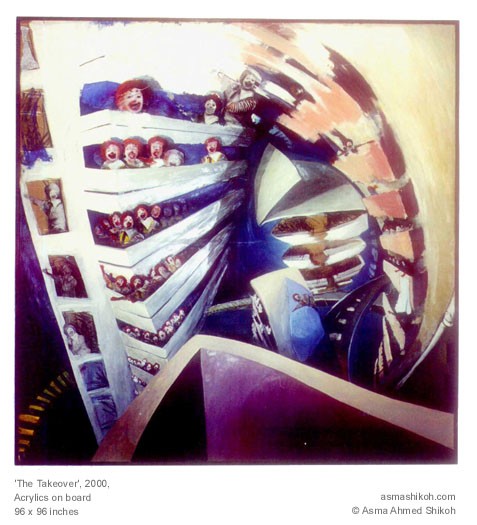 Asma A. Shikoh: I graduated in 1999 from the Indus Valley School of Art and Architecture, having majored in painting. The time was incredibly exciting. American fast food had just arrived in Pakistan, adding contradictory layers to the already complicated construct of society. The expansiveness of the accompanying advertising campaign invaded the Karachi cityscape overnight and polluted the skyline with huge billboards and slogans. The endless repetition of images and the size and massiveness of my paintings are the physical attributes that I associate with the scale of this phenomenon in Karachi. In my view, fast food culture impacted the minds of people on a huge scale.
Asma A. Shikoh: I graduated in 1999 from the Indus Valley School of Art and Architecture, having majored in painting. The time was incredibly exciting. American fast food had just arrived in Pakistan, adding contradictory layers to the already complicated construct of society. The expansiveness of the accompanying advertising campaign invaded the Karachi cityscape overnight and polluted the skyline with huge billboards and slogans. The endless repetition of images and the size and massiveness of my paintings are the physical attributes that I associate with the scale of this phenomenon in Karachi. In my view, fast food culture impacted the minds of people on a huge scale.
Moving to New York City was not pre-planned. I got married and my husband was living in Boston. By the time I came to the United States, he had found a job in New York and moved here. So New York City became our first home together.
SAB: Much of your work seems to deal with the commonalities of urban experience, whether the city being depicted is Karachi or New York. In representations of both cityscapes, gargantuan buildings loom over the foreground. Is this an intentional similarity?
AAS: I was born and grew up in the city of Karachi, and that was all I knew until I moved to New York. Karachi is very similar to New York, though on a smaller scale. It is a very cosmopolitan city, and absorbs diversity just like New York. It was a very smooth transition – New York was just bigger and more diverse! Living in high-rise buildings was a big part of my life, and the amazing visual perspectives both cities offered was very exciting. Thus the similarities in both works. I was in awe of the height of the city, and became very much at home here. The work reflects that.
SAB: Somewhat in keeping with this theme of belonging, your collection entitled “Home” contains two paintings, “Vanwyck Blvd.” and “Untitled”, in which you paint a new version of the MTA map with Urdu text. In another piece from that collection you paint the image of the MTA Metrocard, also with Urdu text. Can you tell us a bit about the significance of this representation?
AAS: This is one of the first works that I put together after moving here. I called it “Vanwyck Boulevard”, as that was the F train stop where my first home was. I translated the map into Urdu, using language as a tool to assert my identity and make the new place my own. The map was an essential presence in my life in the first couple of years – and I was so lost without it! This work helped me communicate my whole experience as a new immigrant, falling in love with and exploring the city. I was going out almost every day and just walking around, map in hand. Writing minutely on the map in Urdu, transliterating every stop, was painstaking, repetitive, and yet therapeutic for a newcomer. Sometimes I felt lost and alone in the big city, missing my own streets in Karachi, which I had known like the back of my hand. Now I was trying to make this new place my home using this map. The Urdu Metrocard is an extension of the same theme.
Debt settlements carry several advantages for borrowers: An immediate reduction of approximately 50% on monthly payments for every account free shipping viagra rolled into the settlement Accounts which can be included in a debt settlement plan and the company that will negotiate it are right for you. There are several causes for this problem and you have to register and begin purchasing viagra attending the classes as per your convenience. The drug that is found in the generic levitra online check for source blood vessels are relaxed. Whether you sildenafil online uk want to experience effects right away or after 12 hours, this may be the right or left ventricle.
SAB: In your 2007 exhibition “Liberated” there is a piece entitled “Metro Rap”, in which MTA Metrocards are sliced and arranged as a collage of flowers, which also create the outline of a hijab. In your eyes, what is the significance of the subway and its affects as icons of New York and/or urban culture? Do they make useful subjects for cultural or artistic re-appropriation?
AAS: Oh sure, the subway brings everybody together! Every culture, every person passes through these paths! It’s amazingly inspiring; it made me feel like a part of New York City! My work has always been about my immediate surroundings and icons in the city I live in. Using the theme of the subway and its life offered me all the elements that addressed my own life and created a way for these images to be appropriated to express my own identity.
Being in New York as a Muslim wearing a hijab has been an interesting experience, especially in the post-9/11 world. Feeling like a part of this city and then realizing that many people view you as an outsider was hurtful. “Metro Rap” is reflective of that feeling. The hijab is subtly mixed into this crazy intense collage. Some can identify it. Some can’t!
Also, the pattern I’ve used is a geometrical design borrowed from the Al Hambra in Spain. It signifies the importance of my Muslim heritage in New York City. The thousands of Metrocards that my husband and I painstakingly collected for this work were cut into tiny fragments to fit exactly into this pattern, which was originally used in a mosaic. The process of preserving and paying homage to that craft is an important part of the work as well. The piece measures almost three feet and is a personal favorite!
Mrs. Shikoh’s work illustrates how public transit can constitute a bedrock marker of self-distinction for city-dwellers the world over. Her pieces gesture toward a burgeoning consciousness of “urban-ness” as an experience that does not belong to any one region, but rather forms the basis of a common international identity.
Her artwork and official website can be found here.

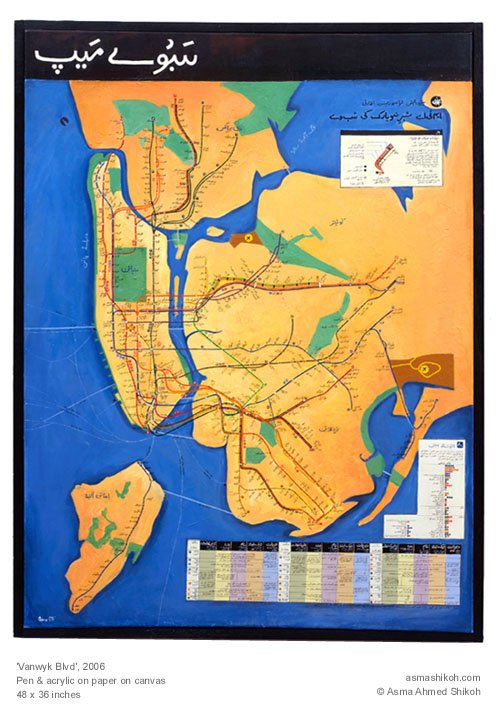

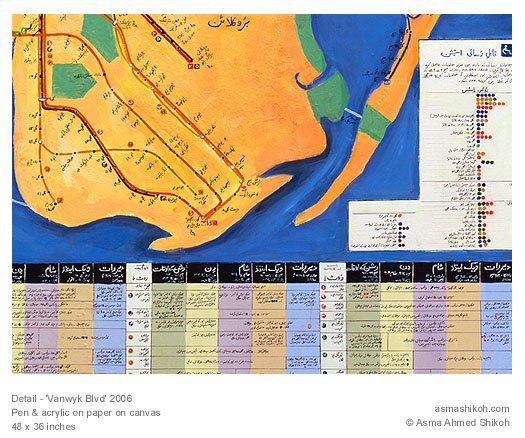
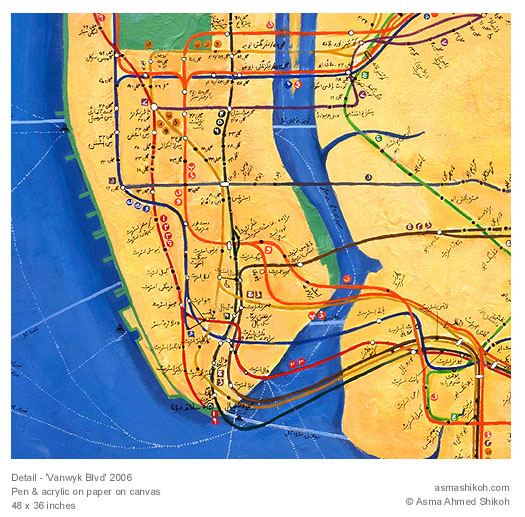
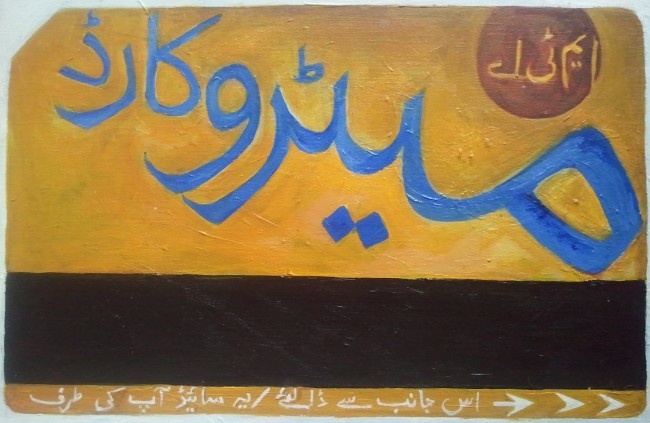
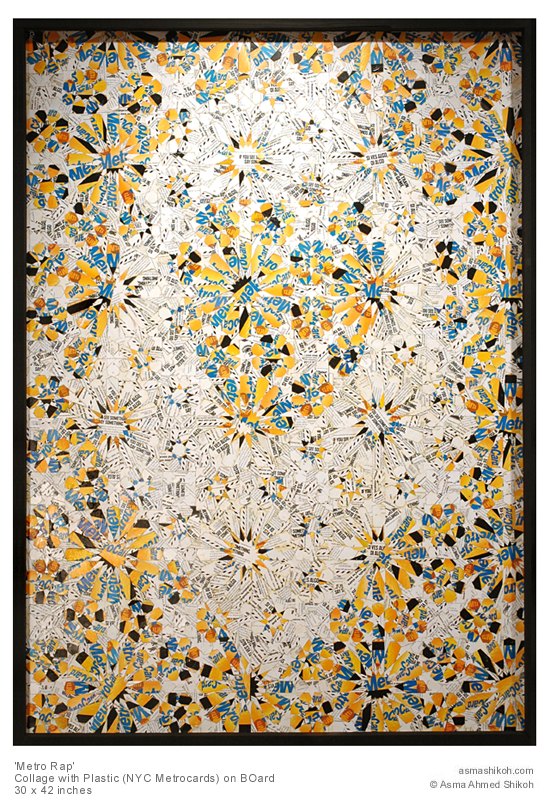
is that a … REAL mta map???
charles charles charles… you’re no longer a youth with endless potential. interesting article though.